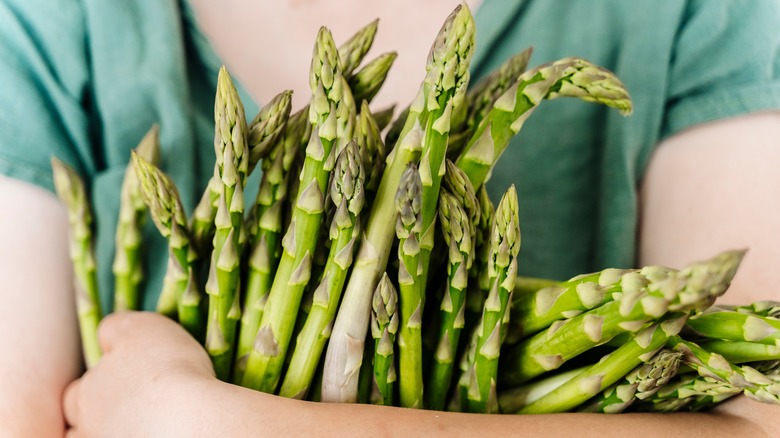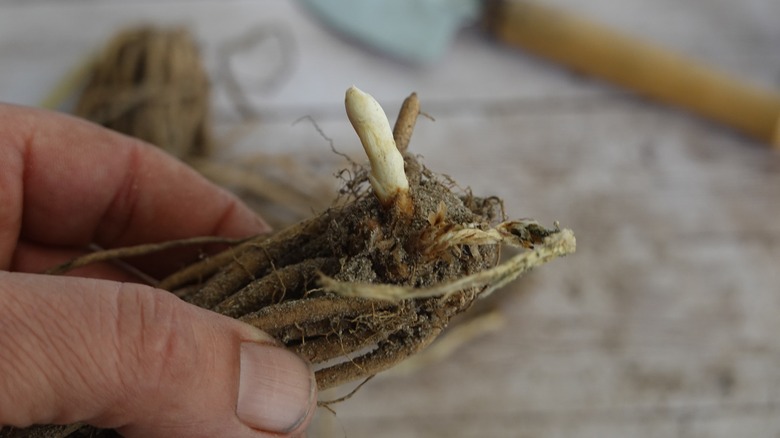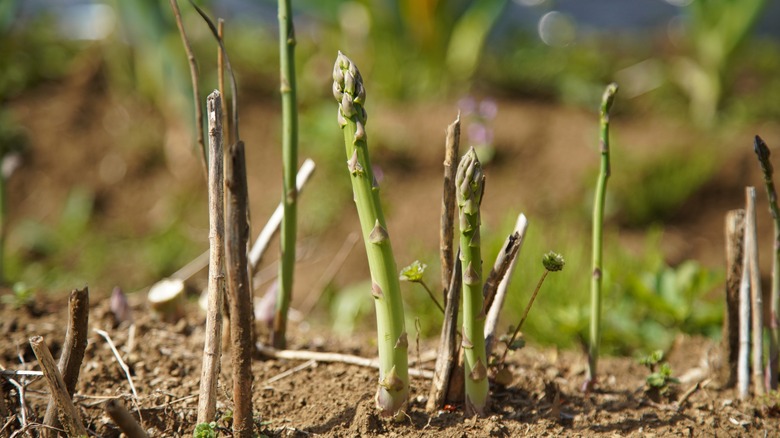Don't Try Regrowing Asparagus From Grocery Store Produce. Do This Instead
Asparagus is an expensive vegetable, and for good reason. The high price stems from a long growing process that's far more arduous than that of, say, lettuce. And unfortunately, you can't get around it by easily regrowing store-bought asparagus at home. As Tiffany Selvey, House Digest's master gardener, explains, trying to regrow asparagus spears you've bought in the store is a bad idea as it could take up to five years, and "the asparagus stalk would need to have some root portion still attached," which is often chopped off of store-sold spears. She also notes that "the variety is almost certainly not going to be appropriate for the area in which someone wants to grow it," as asparagus is often brought in from warmer locations like Mexico.
Instead of embarking on a multi-year experiment that may or may not work, plant asparagus the way most farmers do it — from crowns (year-old roots) or seeds. Crown planting is the easiest, since you don't need to replant seedlings and you can harvest the spears sooner. Seed planting takes longer, but it's a good option if the crowns are no longer available for the year.
What to do instead of regrowing store-bought asparagus
Rather than regrowing grocery store asparagus, you can buy asparagus crowns from local nurseries or online retailers in the spring. If you're not ready to plant when the crowns arrive, keep them in the fridge. Before you plant, make sure your soil is prepped — asparagus prefers neutral soil and is finicky about nutrient content, but treating the soil with 10-10-10 fertilizer should do the trick. Crucially, make sure the soil does not accumulate water — it should drain well, regardless of the type of soil you're using. When you're ready to plant your asparagus crowns, dig a foot-deep trench, allowing for another foot of space for each asparagus crown. Next, lay out the crown's root end-to-bud and backfill the trench with about a quarter of the soil you dug up. Continue to fill the trench gradually as the shoots emerge.
You can also plant asparagus from seeds, although this method will add a year to your harvest wait time. You'll need to plant the seeds in a sandy part of your garden in spring, inserting them about an inch under the soil surface. Before the cold sets in later in the year, winterize the nursery bed with straw mulch. Then, in the spring of the following year, you can replant the asparagus seedlings into a trench with a foot of space between the plants.
Taking care of your asparagus plants
Before the asparagus seedlings get established, you'll need to water them generously at least once per week. As the plants mature, continue to water at the same frequency, but don't soak the soil — getting it wet an inch or two should suffice. Knowing how much fertilizer you'll need is also important for the plants, and you should add a layer of compost around them at the end of the growing season. Alternatively, you can use the same 10-10-10 fertilizer you treated the soil with prior to planting. One thing to pay attention to — especially with young plants — is weeds. Uncontrolled weeds starve the asparagus plants of moisture and nutrients, so be sure to monitor the beds and remove weeds when they emerge.
Getting a bountiful harvest of asparagus demands patience on your part. New spears will appear every spring as the perennial comes back to life. You may be tempted to harvest these spears, but it's best to leave them alone for the first and second year after planting the crown (that's three years if you started with seeds). This way, the asparagus spears will turn into ferns — these aid plant development by packing the roots full of nutrients. At the end of the two (or three) year wait, you can safely cut fresh spears for about half a month every spring, leaving the rest to become ferns and keep the plants properly nourished.


